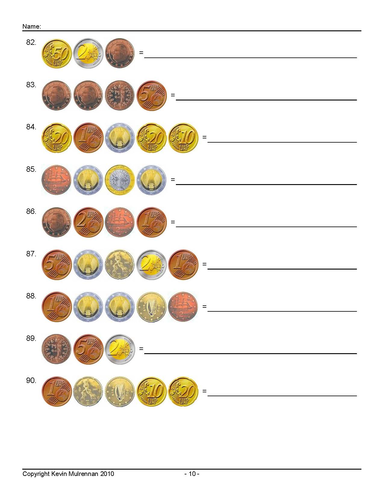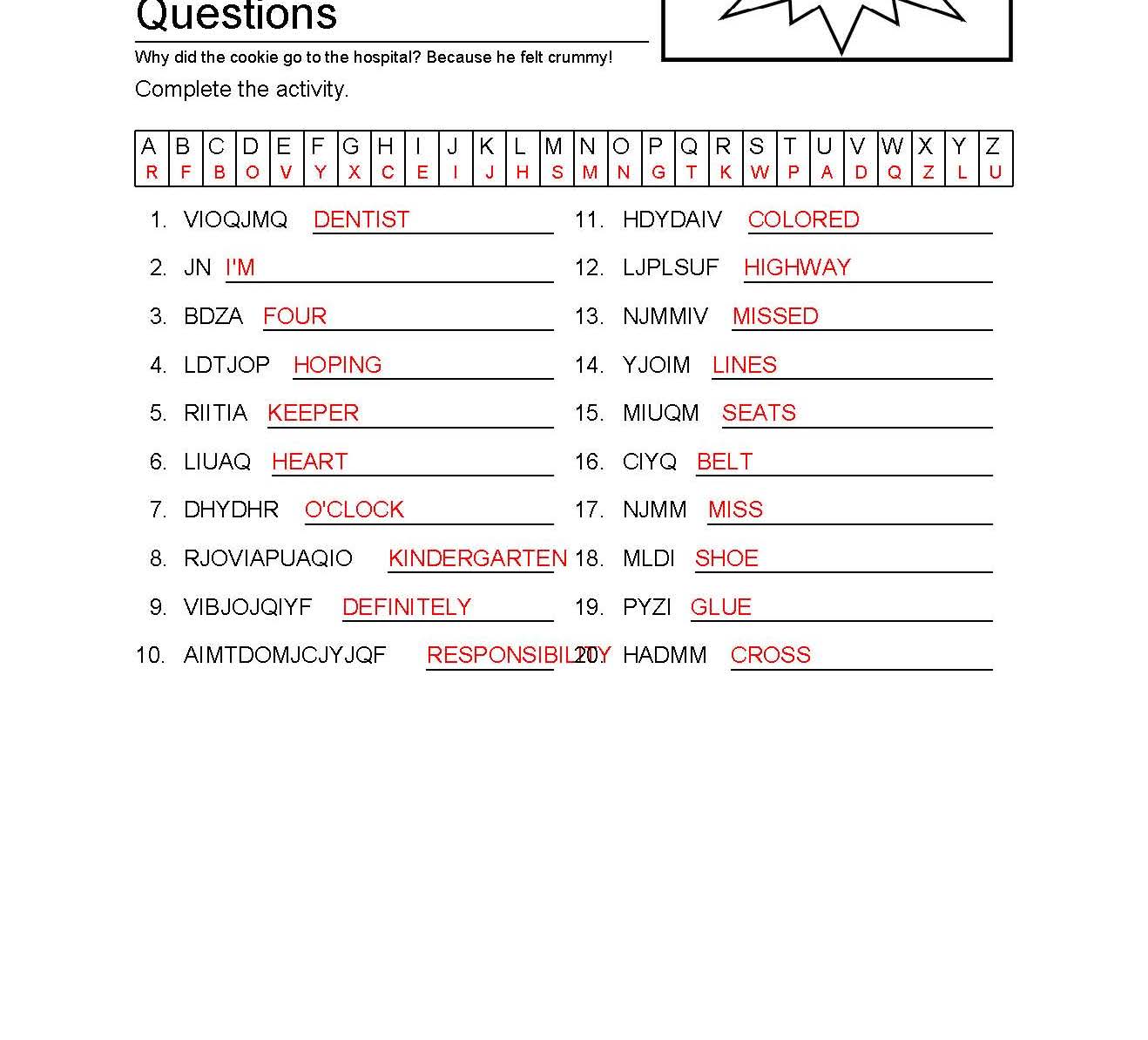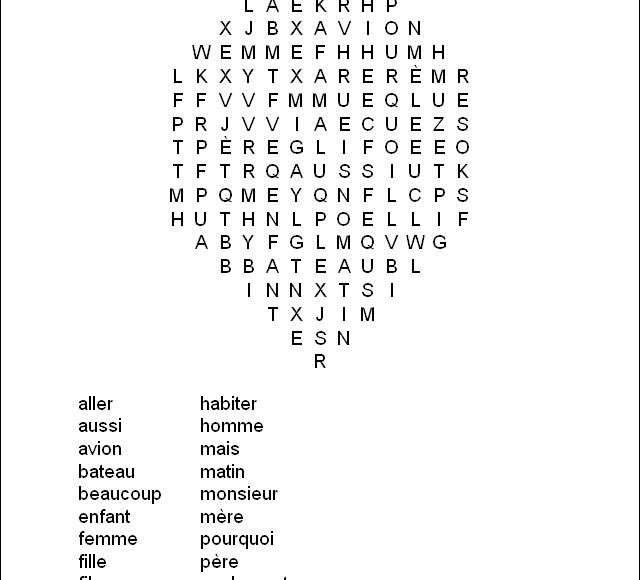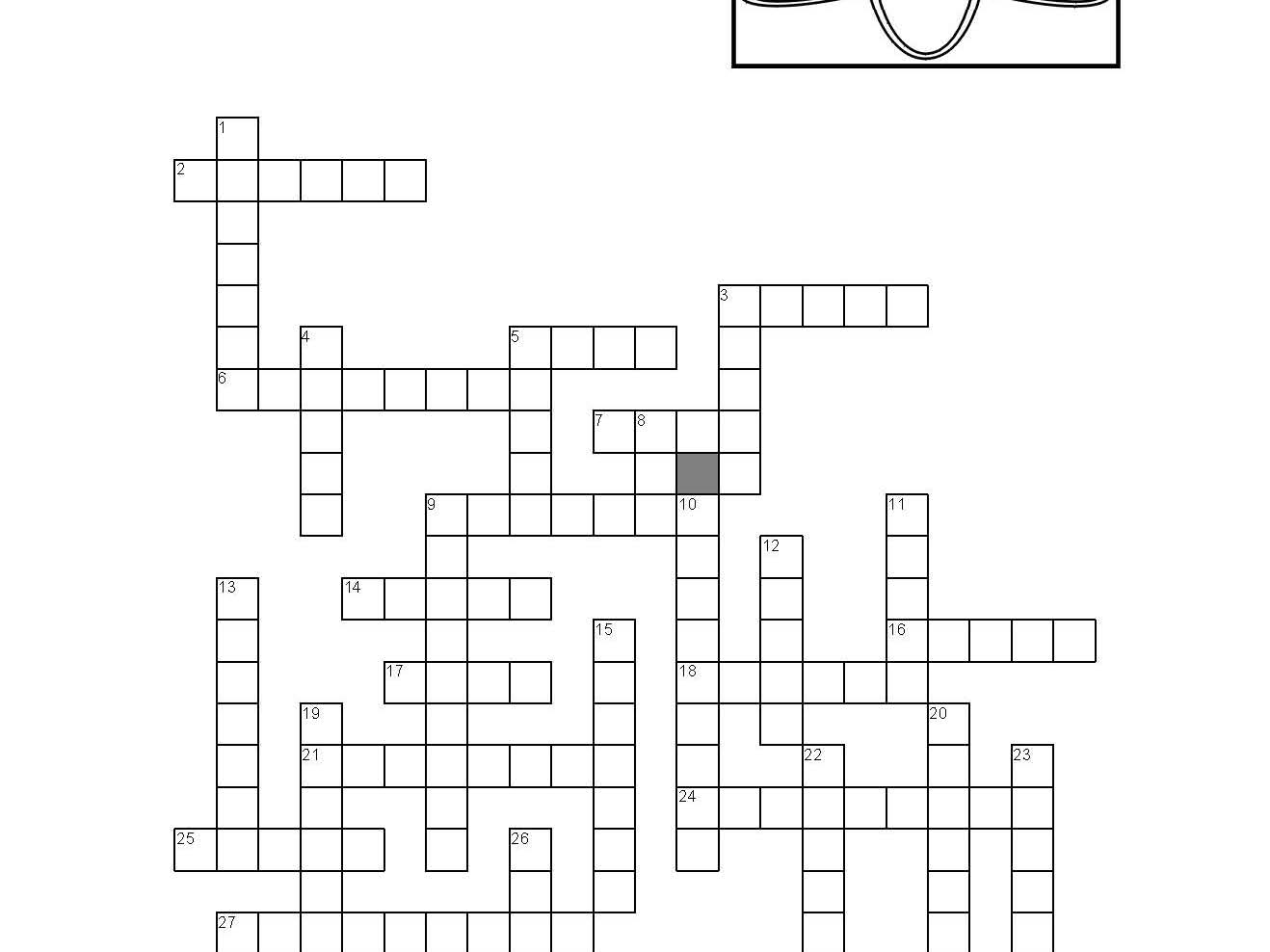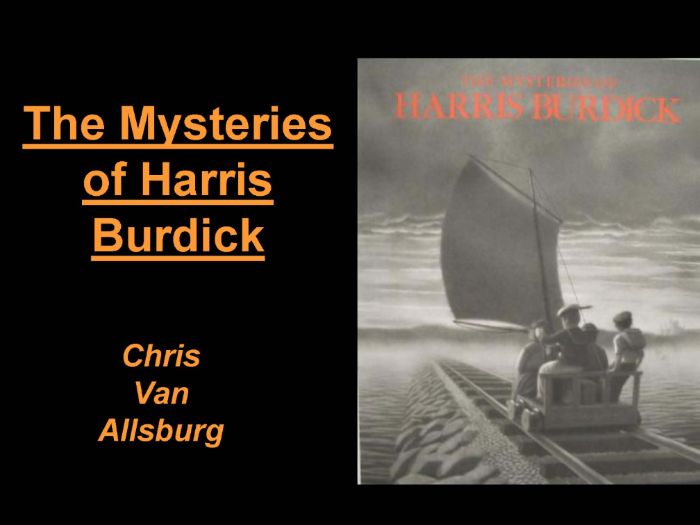357Uploads
98k+Views
28k+Downloads
World languages

Freebie 2 French Wordsearches KS1 KS2 Perfect for Friday Afternoons With Answers
2 French wordseaches with answers.
Each one has 20 basic words to find.
Perfect for rainy Friday afternoons, homeworks etc.
If you like these, please visit my shop where you can purchase 500 of these at a very reasonable price.

Euro Coins Worksheets KS1 KS2 Mathematics Freebie
A worksheet that pupils have to fill in. They have to add up the coins.
If you like it, please visit my shop that has an enhanced similar product.
Sale

Euro Coins European Worksheets 500 Questions Mathematics Counting KS1 KS2
500 questions on counting up Euro coins.
5 worksheets with 100 questions each.
There are little pictures of the coins and the pupils have to add them up and write the answers on the sheet.
Bundle Sale

Bundle Coins Worksheets UK Euro Shopping
A good value bundle.
Fill in the worksheets on counting Euro coins, UK coins and a series of shopping questions that test knowledge of money etc.
Bundle Sale

11+ Grammar School Prep Worksheets Bundle Maths Puzzles Synonymn Literacy
Great value bundle.
Great preparation for the grammar school exams.
Ideal for parents or tutors.
All answers provided.
You’ll never run out of material with this great bundle!
Included:
11+ Grammar School Antonym Questions Literacy Worksheets
11+ Grammar School Synonym Questions Literacy 100 Worksheets with Answers
11+ Verbal Reasoning Decoding Vol 1 Maths KS2
11+ Verbal Reasoning Decoding Vol 2 Maths KS2
11+ Verbal Reasoning Questions Letter Patterns Vol 1
11+ Verbal Reasoning Questions Letter Patterns Vol 2
Bundle Sale

Bundle Coins UK and European Plus Maths Adding Up etc
A great value bundle.
Worksheets on adding up UK coins.
Plus Euro ones.
Plus some general maths stuff.
Teaching Resources 100 worksheets Coins KS1 Teachers Counting KS1 KS2
Euro Coins European Worksheets 500 Questions with answers Counting KS1 KS2
1000 questions Mathematics KS2 Multiple Addends 2 Digit Numbers
11+ Verbal Reasoning Questions Letter Patterns Vol 1
Bundle Sale

Bundle coins plus ones on Money and Fractions
A bundle.
Worksheets on UK coins plus ones on Euro coins and shopping and half a million on fractions.
Euro Coins European Worksheets 500 Questions with answers Counting KS1 KS2
Teaching Resources 100 worksheets Coins KS1 Teachers Counting KS1 KS2
Teaching Resources worksheets Money Shopping cd KS2 Mathematics Coins
Teaching Resources 500000 Questions Fractions Maths
Sale

500 French Wordsearch KS1 KS2 Friday Afternoon Treat Homework France Wordsearch
A zip file containing 500 French wordsearches I’ve designed.
All answers provided.
10 sets of simple words. 50 different shapes.
A big file so please be patient when downloading.
Ideal for Friday afternoons, homeworks, fun etc.
Each worksheet has 20 French words to find.
Bundle Sale

Bargain bundle Literacy Crosswords Word Searches Antonymn Synonym KS2
Bargain bundle
worksheets on
Antonymns
Synonymns
Literacy word searches
Literacy cross words
Bundle Sale

Mathematics Worksheets bundle KS2 Counting Coins Subtraction Division
A great bundle of worksheets I’ve made.
Please check my shop to see the individual desriptions.
Bundle Sale

Bundle 100 worksheets Roman Numerals & 500 Latin Wordsearches
Bundle
Great for Classicists.
100 sheets that test knowledge of Roman Numerals.
500 Latin word searches.
See shop for full details
Bundle Sale

Bundle 11+ Prep Antonym Synonym Letter Patterns Vol 1
Bundle.
Good value.
Please look at my shop for details.
Sale

RE Christmas lesson Four Powerpoint and Planning Catholic Flavour
Lesson four in my nice Christmas unit.
Please look at the others to get the idea.
Nice powerpoint ion this one.
Sale

European Day Of Languages Powerpoints France Spain Italy
For the European day of languages, but can be used anytime.
Useful info on France, Spain, Italy, Greece, Germany, Sweden and Wales.
Brilliant for assemblies.
Great value as there is a lot of stuff.
Sale

Shakespeare Week Lesson Plan For Year 6
Suitable for year 6.
Worked very well for me.
For instance the first day :
Grammar Starter
http://www.oxforddictionaries.com/words/apostrophe
L.O: Know one of Shakespeare’s stories.
Success Criteria
Know some background information about William Shakespeare, his time and his work.
Describe the basic plotline of ‘A Midsummer Night’s Dream’
Start to talk about the main characters; their hopes, desires and challenges.
Main teaching:
Who was William Shakespeare?
http://www.bbc.co.uk/schools/primaryhistory/famouspeople/william_shakespeare/
Use above website to read about his background – note that he wrote plays – his works were intended to be acted.
http://www.opensourceshakespeare.org/views/plays/plays.php
Use the above website to look at the list of plays – discuss terms tragedy, comedy and historical play.
Read ‘A Midsummer Night’s Dream’ shortened, story version. Explain that this was written in 1595.
Sale

English year 5 and 6 The Mysteries of Harris Burdick Planning and Powerpoints Literacy year 5
A great collection for teaching this interesting topic.
You get powerpoints and planning.
Sample :
Punctuate sentences accurately, including using speech marks and apostrophes.
Use commas to mark clauses.
Group and classify words according to their type and meaning.
Read a variety of texts, commenting on the author’s choice of vocabulary.
Construct sentences which are punctuated correctly; including the use of commas, speech marks and apostrophes.
Use a range of connectives to join sentences.
Experiment with complex sentences.
Whole Class Shared Learning
Discuss pronouns (homework)
Define each type of word: Noun, adjective, verb and adverb. Build up a sentence as we go.
Show the children a picture on the whiteboard of a horse galloping and of a lightning bolt. Children to write down 3 (LA) or 5(MA and HA) important nouns from the picture. Share. On the left of the noun, children to write an adjective to modify or describe the noun. Share. After the noun, children to write a verb and then an adverb to qualify the verb.
e.g. The black horse galloped elegantly along the beach.
Praise the children on yesterday’s literacy work – they showed knowledge of the function of nouns, adjectives, verbs and adverbs (HA showed knowledge of the difference between common, proper and pro nouns).
Children to name a range of punctuation – I record on the board (I do not add to it at this point).
Ask volunteers to illustrate uses of the punctuation named. Look on the punctuation pyramid – have we named any L5 punctuation? This is what we should be aiming at all the time.
Children to have a variety of sentences to up level punctuation on their whiteboards.
Come back to ‘The Mysteries of Harris Burdick’. Read through all of the captions and talk about ‘reading’ the illustration. Allow children time to talk about the ‘mystery’ – what do they think happened to Harris Burdick?
Choose a picture from ‘The Mysteries…’ and list all of the questions which it provokes. What do children think of the pictures? Do the captions answer any of the questions?
Talk about the settings in the pictures – often they are recognisable, familiar settings where things are not as they seem. Explain that we would call this ‘Stories in a familiar setting’.
Model the task.
Use PPT to study speech punctuation.
Use the pictures from ‘The Mysteries…’ to write some possible dialogue.
Model possible conversations, including synonyms for said and adverbs plus adverbial clauses. With correct punctuation.
Look at some of the pictures from ‘The Mysteries …’
Think / discuss some of the characters in the pictures. Use adjectives to describe them – give them names. From the pictures come up with verbs to describe what they are doing then add adverbs and adverbial clauses.
Sale

Back To School French Primary School Resources and Lessons
Have you been volunteered (know what I mean?) to deliver Modern Languages at your Primary School?
This bunch of resources, that I used in my decades of French teaching, will help.
I’ve put them into groups to help you.
the zip file has loads. I’ve put a selection as downloads so you can have a look at them.
Highlights include:
festivals
games and activities
how to
ideas for lessons
phonics
poems
loads of powerpoints
songs
stories
Sale

Easter Lessons Through Literature Planning Powerpoints Worksheets Road To Emmaeus
Materials for teaching Easter and Jesus and his disciples.
Planning powerpoints etc.
Road to Emmaeus board game.
Sale

Back to School The Piano by Aidan Gibbons Year 6 Literacy Planning
Great planning and powerpoints on this fascinating topic.
sample :
Speaking
• Tell a story using notes designed to cue techniques such as repetition, recap and humour
Drama
• Reflect on how working in role helps to explore complex issues
Understanding and interpreting texts
• Infer writers’ perspectives from what is written and from what is implied
• Compare different types of narrative and information texts and identify how they are structured
Creating and shaping texts
• Reflect independently and critically on their own writing and edit and improve it
• Experiment with different narrative forms and styles to write their own stories
Sentence structure and punctuation
• Adapt sentence construction to different text-types, purposes and readers
• Punctuate sentences accurately, including using speech marks and apostrophes
Understand, analyse and compare several ‘visual texts’.
Comment on the technical parts of a visual text.
Write a review using correct format and language.
Whole Class Shared Learning
Guided and Independent Activities:
Start to understand what is meant by a ‘visual text’. What do we know so far about narrative writing? Create a list of facts to add to working wall including: fictional, dialogue, opening etc.
Explain to the children briefly, that they are going to watch a short, animated film, entitled ‘The Piano.’ Explain also that there is no dialogue or narration; it will be up to the children to decide what the film is about, to answer simple questions, raise some of their own and provide their own explanations for what they see.
Tell the children that they’re going to watch the film, quietly and without comment at first. Then, watch ‘The Piano’ by Aidan Gibbons.
Model completing thinking feeling and speech shapes linked to the narrative.
Sale

Year 5 Poetry Planning Poetic Style – Valerie Bloom/Pie Corbett
Nice planning :
sample :
Read 3/4 Pie Corbett poems (see list below this plan or plan resources) – NOT Wings. Discuss the poems read eg which one did you like best and why? Is anything similar about the poems? Focus their attention onto things that are typical of Pie Corbett. Use 3 headings: Subject matter/Style of poem/Language. Discuss each of these (subject matter is what the poem is about eg nature, travelling, observations etc). Style is free verse or strict rhythm/regular or irregular rhyming patterns, use of speech or dialogue etc. Language refers to the vocabulary – the use of adjectives and descriptions, metaphors or similes eg ”I heard the paving slabs groan as they muscled for space.” (See plan resources.) Start looking at poems of Pie Corbett under these 3 headings. Give chn time to talk in pairs/small groups about each heading and take feedback. Ask chn to come up and scribe some ideas under each heading. Explain that we will now be exploring some of these headings in more detail. Easy
Give chn a selection of Pie Corbett poems. Model reading a couple to the chn. Discuss what was similar or different in terms of the subject matter. Chn to then read some more poems in pairs and start to sort them into groups that are similar and why. Stick the similar poems onto A3 paper and make rough jottings about why they are similar. TD Medium/Hard
Work in pairs or 3s. Take turns to pick a Pie Corbett poem and read it out loud to rest of group. Repeat this until lots of poems have been read. Provide highlighting pens & poetry checklist (plan resources) to guide their discussion. Ask chn to go back over each poem carefully & highlight any language that makes the poem interesting eg adjectives & descriptions. Give chn the metaphor & simile example sheet (plan resources) to refer to and see if they can highlight any of these in another colour. Make sure chn annotate their highlighting with their own comments. Is there anything linking these Pie Corbett poems together? Does he repeat any language techniques? Finally they look at the style of the poems. Is there a regular rhythm in the poems? Do they use speech?


